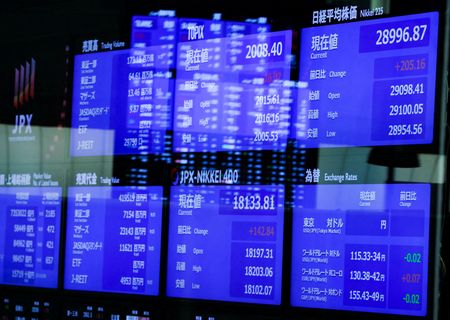By Jamie McGeever
(Reuters) – A look at the day ahead in Asian markets from Jamie McGeever.
U.S. economic activity indicators on Tuesday accelerated the relentless march higher in U.S. interest rate expectations and confirmed that, for financial markets at least, good news is most definitely bad news.
Wall Street and world stocks had their worst day this year after purchasing managers index data showed that the U.S. services sector is roaring back to life. Asian markets are likely to follow when they open on Wednesday.
Not one of the 18 economists polled by Reuters expected the services PMI to bounce back above the 50.0 threshold between contraction and expansion, and the shockwaves were felt across all asset classes.
Stocks slumped, volatility and the dollar rose, the two-year Treasury yield neared November’s post-2007 peak, the implied U.S. terminal rate rose to a new high of 5.36%, and a potential 50 basis point rate hike next month is coming on traders’ radar.
As analysts at Schroders put it: “A new regime in policy and market behavior is unfolding before our eyes.”
This is not an emerging market-friendly mix. If the dollar and U.S. yields continue to rise, one of this year’s consensus trades and the allocation of hundreds of billions of dollars to emerging markets will have to be revised.
The geopolitical backdrop is not improving either.
Days from the one-year anniversary of Russia’s invasion of Ukraine, Vladimir Putin announced Moscow will suspend a nuclear arms treaty, and the United States and its allies prepared to impose new sanctions on Moscow.
China appeared to signal support for Russia and the Wall Street Journal reported that Chinese leader Xi Jinping is preparing to visit Moscow for a summit with Russia’s president Vladimir Putin in the coming months.
Back to the economics and policy, and the Reserve Bank of New Zealand is expected to slow the pace of its tightening campaign on Wednesday, and deliver a 50 bps hike to 4.75%.
That’s the view of 20 out of 25 economists polled by Reuters, and the other five are going for a second successive 75 bps move.
If the Fed is as hawkish as markets think it will be it is difficult to see other central banks – developed and emerging market alike – keeping pace. This would cast major doubt over another of this year’s consensus ideas – a weaker dollar.
Here are three key developments that could provide more direction to markets on Wednesday:
– New Zealand central bank rate decision
– Australia hourly wages (Q4)
– Hong Kong GDP (Q4 final)
(By Jamie McGeever; Editing by Deepa Babington)

